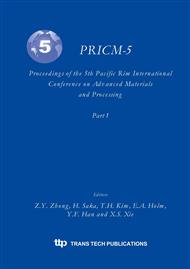p.245
p.249
p.253
p.257
p.261
p.265
p.269
p.273
p.277
Damping Capacity of the Fe-Cr-Al Based Alloys
Abstract:
Based on the damping alloy Fe-13Cr-6Al, five types of alloys are prepared in the present study with 1 at.% of Cr replaced by Mo, Mn or Nb, and 0.5 at.% of Al replaced by Cu. The effects of annealing temperature, vibrating frequency, strain-amplitude and static load on the damping capacity of these alloys are studied through damping capacity measurement and optical microscope observation. The following results were obtained: (1) The damping capacity of Fe-13Cr-6Al based alloys increases with increasing annealing temperature. (2) The replacing elements demonstrate different effects on the damping capacity of Fe-13Cr-6Al based alloys. The damping capacity of the alloys with Cu or Mn substitution increases, while that of alloys with Nb substitution decreases significantly as compared with Fe-13Cr-6Al. (3) The damping capacity of Fe-13Cr-6Al based alloys is not sensitive to frequency. It decreases with increasing in static load, and increases rapidly with strain before reaching a steady state.
Info:
Periodical:
Pages:
261-264
Citation:
Online since:
January 2005
Authors:
Keywords:
Price:
Сopyright:
© 2005 Trans Tech Publications Ltd. All Rights Reserved
Share:
Citation:


